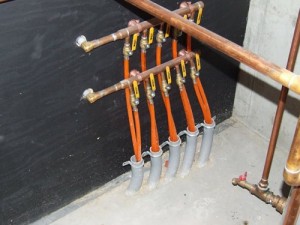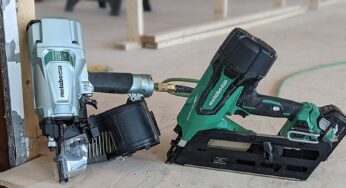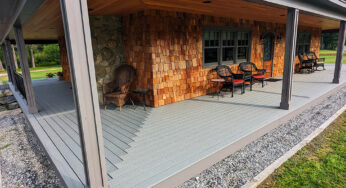Radiant Tubing Into Concrete Slab Detail
Radiant Slab Heat
This post is an answer to a question a reader asked the other day. “How should I treat the radiant tubing into concrete slab detail?”
It just so happens that I installed the radiant tubing in our new home so I’ve got a bit of experience with this detail. Installing radiant tubing in a concrete slab is fairly straight forward. The key is to lay out the loops so that each loop is approximately the same length. Each loops starts and ends at the same point (location of the header manifold).
The easiest way I know how to deal with the location where the radiant tubing exits the concrete slab is shown in this photo. I used a 1 1/2″ electrical conduit 90 degree sweeps for each pair of radiant tubing. The conduit sweeps help make sure you don’t have a kind in the radiant tubing where it exits the concrete.
To support the conduit sweeps and radiant tubing during the concrete pour I pounded two wood stakes into the sub-grade on either end of the sweeps. Then I screwed a scrap piece of wood between the stakes centered at the top of the sweeps. I used metal conduit supports to hold the conduit sweeps securely against the scrap wood (if you look closely at the photo you can see the clamps still in place around the top of each sweep).
I rolled out all of the radiant tubing first. Then I installed the stakes and the scrap wood. Then I just slid the conduit sweeps down over each pair of radiant tubes and secured them in place with the clamps. Once the concrete slab is finished and set up you can just cut off the stakes flush with the slab. As you can see this leaves you with a very neat and organized layout for your radiant tubing manifold.
Recent Posts
Framing Stick Nailer vs Coil Nailer
Which is Better a Stick Nailer or Coil Nailer? Framers have many choices in nailers…
How Many Roofing Nails Per Square of Shingles
Estimating How Many Nails for a New Roof When it comes to estimating materials for…
Composite / PVC Decking – Layout Tips & Advice
Composite / PVC Decking Layout Tips and Advice Composite and PVC decking have really changed…
Benefits of an ERV System (Energy Recovery Ventilator)
Benefits of ERV Systems (Energy Recovery Ventilator) If you're building a new home or doing…
Vermiculite Attic Insulation Abatement
Vermiculite Attic Insulation If your home was built before 1990 there is a chance it…
Nuisance Tripping of AFCI (Arc Fault) Circuit Breakers
Arc Fault (AFCI) Circuit Breakers Tripping Often An arc-fault circuit interrupter (AFCI) or arc-fault detection…




